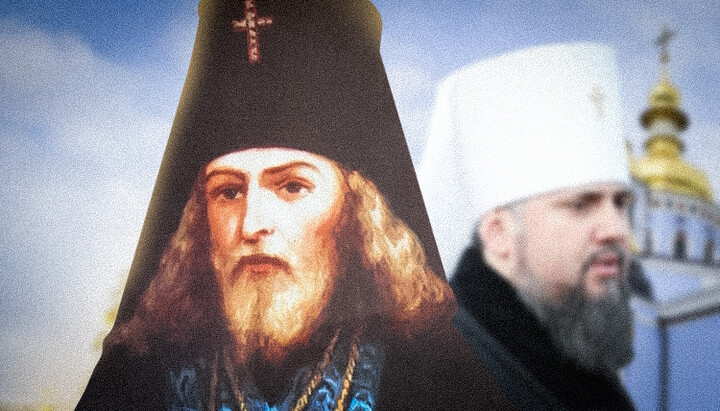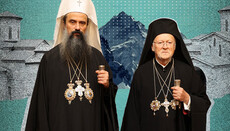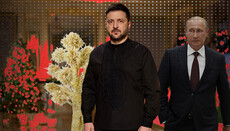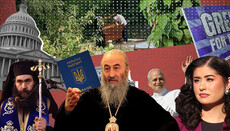Canonisation of "spiritual occupiers"

The OCU calls the stay of the Kyiv Metropolis in the ROC a spiritual occupation and at the same time canonises the saints of that time. Cognitive dissonance? Not that simple.
After the formation of the OCU, the ideologists of this structure were faced with the question of its self-identification. It was urgent to get away from the thesis that this structure emerged only in 2018, and to come up with a 'genealogy.' This work is still in the development stage, but certain contours have already been outlined.
The concept is as follows: from the Baptism of Rus in 988 until 1686, the Kyiv Metropolis existed as a relatively independent Ukrainian church structure (as part of the Patriarchate of Constantinople). In 1686, according to the OCU version, when it was allegedly non-canonically transferred to the jurisdiction of the Moscow Patriarchate, the spiritual occupation began, which lasted for more than 300 years. Consequently, the OCU considers itself the heir of the ancient 'good' Kyiv Metropolis, while the UOC – is the successor of the “spiritual occupiers”, meaning the Russian Orthodox Church that “occupied” Ukraine and must be destroyed today. For example, here is a text that was published on the OCU Facebook page a year ago when this religious organisation started conducting its 'services' in the Kyiv-Pechersk Lavra:
"It is a great spiritual joy and a true blessing of God for the Ukrainian people that the ancient Ukrainian shrine in the heart of the Ukrainian capital has finally begun to be freed from spiritual occupation. For the first time in several hundred years in the main temple of the Lavra, the prayer led by the hierarchs was heard in the native language of the native Ukrainian Church – the recognised local, autocephalous Orthodox Church of Ukraine, which is the successor of the ancient Metropolis of Kyiv.
Yes, indeed, our Church, with the Patriarchal and Synodal Tomos on autocephaly, as well as recognition by the Mother Church and other local Sister Churches, is the canonical successor of the ancient Kyiv Metropolis and then its historical legacy. <...> The Russian Church occupied and actually appropriated the Kyiv-Pechersk Lavra in the 17th century."
The OCU even divided the revered saints of the Kyiv-Pechersk Lavra according to its concept: 100 were deemed “correct”, meaning “Constantinople”, while 20 were considered “occupational”.
And the narrative about 300 years of spiritual occupation and the OCU as the heir to the ancient Kyiv Metropolis is quite simple, beautiful and, like any catchy propagandistic slogan, capable of influencing minds. But such slogans have a rather short period of lifespan. After some time, people start asking questions. And if no clear answers are found, the narrative simply dies. Of course, many propagandistic ideas are designed for short-term action, because during this short period, the necessary decisions are made. But in this case, the OCU needs the above-mentioned narrative to live as long as possible. However, two very simple questions can prevent this:
- What is the real origin of the OCU? Where does it come from, because it was not the hierarchs of the XVII century that "ordained" Serhiy Dumenko as "bishop"?
- How can the OCU established in 2018 be the heir to the Kyiv Metropolis of 1686?
Where does the OCU come from?
If we make very little intellectual effort, we can find out that the OCU indirectly comes from the very same UOC that "spiritually occupied" Ukraine. As we know, on 15 December 2018, the so-called Unification Council took place, at which the OCU was created from the UAOC and the UOC-KP. Serhiy (Epifaniy) Dumenko, who was "ordained" as "bishop" by the former Metropolitan of Kyiv and All Ukraine Filaret Denisenko, at that time already excommunicated from the Church, was elected the head of the OCU. That is, the OCU grows out of the same UOC, which, in turn, emerged from the Ukrainian Exarchate, and before that from the Kyiv Eparchy within the Russian Orthodox Church. The figure of Filaret Denisenko, the founder of the UOC-KP, and then of the OCU, is, to put it in modern terms, very "scandalous": an agent of the KGB of the USSR with the pseudonym Antonov, the locum tenens and the main candidate for the Moscow Patriarchate after the death of Patriarch Pimen, a faithful servant of Moscow on the Kyiv Cathedra, an angry denouncer of Ukrainian nationalism, and so on. We will keep silent about his wife, children and other moral nuances, as this is not the subject of this analysis.
The origin of the Ukrainian Autocephalous Orthodox Church (UAOC), the second component of the OCU, is even more controversial than the UOC-KP. In 1921, several priests took the relics of the Holy Martyr Macarius of Kyiv and "ordained" Vasyl Lipkovsky as "bishop," who, in turn, ordained the rest of the "hierarchy" of the UAOC, earning the historical nickname "self-ordained" for this religious organisation. Both Vasyl Lipkovsky and other priests who founded the UAOC received their episcopal ordinations from the same "spiritual occupiers", namely the bishops of the Kyiv Eparchy within the Russian Orthodox Church.
What is the conclusion? The OCU is the descendants of the same "spiritual occupiers" who were in Ukraine for 300 years, only they are also considered "illegitimate". The continuous chain of episcopal ordinations in the case of the UOC-KP was broken with Filaret Denisenko and his followers, who were defrocked and later anathematized, a status recognised by all Local Churches (including the Patriarchate of Constantinople) until 2018. In the case of the UAOC, there was no episcopal succession at all.
The issue of church succession
Now, the second question: How did the Kyiv Metropolis of 1686 manage to leap through time, spanning over 300 years, and present itself before us in the form of the OCU? If in any state, power is seized by aliens or fellow citizens, but through illegitimate means, there exists the institution of a government in exile.
Such a government, of course, does not rule the state but maintains legal succession with the authority that was unlawfully displaced. In the history of the Church, there were cases where a heretical doctrine became dominant, and the true Church was forced into an underground position. During the period of being in an illegal status, usually with a very small number of bishops, clergy, and believers, the Church persisted as a kind of leaven (the Gospel term), from which it later revived in liberty. If after the transfer of the Kyiv Metropolis to the ROC in 1686, there appeared some church groups that disagreed with it, went underground and survived in that state until 2018, then the OCU could indeed proclaim its origin from these groups, and the above-described concept of self-identification of the OCU could be truthful. However, nothing of the sort happened in the history of the Kyiv Metropolis. There were no bishops who went underground, no church groups that went underground.
On the contrary, Ukrainian bishops and a significant portion of the clergy gained substantial benefits from the transition to the Russian Orthodox Church. Even Peter the Great introduced the practice of appointing Ukrainian, or as they were then called "Little Russian" bishops to Great Russian Thrones. The first such bishop was Stefan Yavorsky, a native of the town of Yavoriv near Lviv, appointed by Peter I as the locum tenens of the Moscow Patriarchal Throne. Later, Peter's favourite Feofan Prokopovich, at the behest of the Russian Tsar, developed a church reform that deprived the ROC of a patriarch and any independence from secular authorities, effectively turning it into one of the state institutions. A few decades later, all bishops' chairs in the Russian Empire were occupied by natives of Ukraine. Russian emperors generally admired Ukrainian bishops for their scholarship, favoured them, and, in turn, received loyalty and faithful service.
Since, as mentioned earlier, there was no underground or catacomb church formed in Ukraine that would declare itself the successor to the ancient Kyiv Metropolis and then pass on this succession to the OCU, the latter has no grounds to claim such a succession.
But an amazing process takes place: while essentially referring to the Kyiv Metropolis within the Russian Orthodox Church as "spiritual occupiers", the OCU nonetheless canonises the hierarchs of that time, i.e., according to the logic of the OCU, those very "spiritual occupiers".
Metropolitan Raphael of Kyiv, Galicia and All Little Russia
As an example, let's consider the personality of Metropolitan Raphael (Zaborovsky) of Kyiv, Galicia and All Little Russia (1677–1747), "canonised" by the Orthodox Church of Ukraine (OCU) on July 27, 2023. He was born in 1676 in the town of Zboriv in the Ternopil region, educated in Jesuit schools, and later at the Kyiv-Mohyla Academy. In 1723, he became the chief hieromonk of the Russian naval fleet (!). In other words, Zaborovsky was not just a "spiritual occupation" clergyman; he was directly involved in taking care of the "occupant" army without any "spiritual" attachments. If extrapolated to the present day, it would be like if the OCU canonised an ROC chaplain of the Russian navy.
Later, Zaborovsky served a short time as the archimandrite of the Trinity Kalazin Monastery in Tver. In 1725, he was consecrated as the Bishop of Pskov, Izborsk, and Narva and appointed as a member of the Holy Synod (at that time, this body was considered a collective patriarch). This very rapid career growth could undoubtedly only happen with the favour of the Russian authorities.
In 1731, by the decree of Empress Anna Ivanovna, Bishop Raphael was appointed head of the Kyiv Metropolitical See, which had been downgraded to the status of an archdiocese by his predecessor, Metropolitan Varlaam (Vanatovych). Incidentally, this bishop could have been a candidate for canonisation in the OCU, as he protested against the downgrading of the status of the Kyiv Metropolis and its other rights and privileges, for which he paid a heavy price. He was reported to Moscow, defrocked and sent into confinement at the Kirillo-Belozersky Monastery. In his place, Raphael (Zaborovsky), who was loyal to Moscow's authority, was appointed.
As the head of the Kyiv See, Bishop Raphael proved to be an outstanding church figure. He did a lot for the Kyiv-Mohyla Academy and students in general. He made every effort to eradicate shortcomings in church service, improve the clergy’s morale and combat alcoholism, among other things. His contribution to church architecture is also significant. Under his care, the Great Bell Tower of Kyiv-Pechersk Lavra was built and the restoration of St. Sophia Cathedral was carried out, including the construction of a magnificent iconostasis, a notable monument of Ukrainian Baroque. The construction of the bell tower of St. Sophia Cathedral and the Metropolitan's House was completed. The grand entrance to the metropolitan residence, known as the Zaborovsky Gate, was built. The construction of Saint Catherine's Greek Monastery in Kontraktova Square was initiated, and new buildings and a church dedicated to the Protection of the Holy Theotokos were built at the Kyiv Theological Academy. Metropolitan Raphael (Zaborovsky) was not a hoarder. Approaching the end of his life, he gave away almost all of his property, bequeathing the remaining funds to be given to the clergy for soul commemoration.
All of this is essentially sufficient for canonisation. Many saints have been canonised by the Church for similar merits. But by the criterion of patriotism (which is the main factor for the OCU), the activities of Metropolitan Raphael are not so straightforward.
He indeed tried to defend the rights of the Kyiv Metropolis, appealing to Moscow rulers to improve its financial condition and restore its former rights and privileges. For example, in 1742, Zaborovsky sent a request to the Holy Synod to allow him to appeal to the Moscow Tsar regarding the needs of the Kyiv Metropolis. According to the Kyiv Metropolitan, these needs included the following:
- to prohibit secular authorities from interfering in church affairs (interesting, isn't it?);
- to prohibit the involvement of priests in secular courts;
- to confirm the provisions of the "Letter of issue" (permission) of 1686 regarding the transfer of the Kyiv Metropolis from the Constantinople Patriarchate to Moscow, preserving all the traditions and privileges of the Kyiv Metropolis;
- to lift the ban on transactions of churches and monasteries with lands;
- to assist the "overseas eparchies" of the Kyiv Metropolis, i.e., those that had passed to Poland under the Truce of Andrusovo;
- to restore the right of the Kyiv Academy to receive 200 rubles per year for the maintenance of teachers, repairs to buildings and the temple;
- to compensate the funds spent by Ukrainian churches and monasteries on the needs of the Russian army and officials in the sum of 3091 rubles and 35 kopecks.
Those requests were not fulfilled, except that the Kyiv Academy started receiving 200 rubles, and it was decided that before summoning the clergy to a secular court, it was necessary to consult with the church authorities. As a consolation, by the decree of Empress Elizabeth Petrovna dated June 2, 1743, Bishop Raphael was reinstated with the title of metropolitan, and the Kyiv Metropolis regained the status of a metropolis. However, not only were all other privileges not returned, but the policy of gradually reducing them continued.
On the other hand, Metropolitan Raphael (Zaborovsky) wrote enthusiastic panegyrics and thank-you letters to Moscow rulers, accepted expensive gifts from them and positioned himself as a loyal vassal of Moscow.
Perhaps, the most discrediting action of Metropolitan Raphael in the eye of the OCU was his campaign against old (Ukrainian) books, replacing them with new (Moscow) ones. In a Facebook post mentioned earlier, the OCU describes this as an example of the "misdeeds" of "spiritual occupiers": "Until the 17th century, the liturgical language in the Pechersk (Сaves) Monastery was the Church Slavonic language of the Ukrainian edition, which was banned and replaced with Moscow's by order of Tsar Peter I. <...> Thus began the censorship of Ukrainian books in the 17th century. <...> And then these censorship scorpions from Moscow moved forward by a long series."
Metropolitan Raphael (Zaborovsky) did just that. On July 14, 1742, he issued a decree for the complete withdrawal of old service books from all churches of the Kyiv Metropolis, and on October 6, 1743, a decree was issued to introduce a complete set of new liturgical books in all churches. Although the issue was not only or primarily about the language, but that the old liturgical books contained many distortions and discrepancies with the Greek originals and required not just linguistic but content correction.
The significance of canonising "spiritual occupiers"
There are plenty of facts demonstrating Raphael's (Zaborovsky) faithful service to the "spiritual occupiers". So why did the OCU canonise him, especially when he was engaged in activities that the OCU attributes to many bishops, both of the past and present, as blameworthy?
The reason seems to lie in the following. Unable to prove its institutional connection to the Kyiv Metropolis of 1686, the OCU attempts to establish an ideological line of succession. By canonising figures of that epoch, it promotes a narrative that the Ukrainian patriotic Kyiv Metropolis did not go into the catacombs but existed within the Church that was part of the Russian Orthodox Church. It existed in the personalities of bishops and other figures who, supposedly carrying the ideas of independence for the Kyiv Metropolis and Ukraine as a whole from Moscow, endured for 300 years and finally revived in the form of the OCU in 2018. The fact that such bishops had to serve Moscow and commit acts inconsistent with today's notion of patriotism could be attributed to the conditions of that time, even presented as an example of the highest wisdom and diplomacy.
We already see such things in modern Ukraine. For example, the head of the Ukrainian Greek Catholic Church, Andriy Sheptytsky (who warmly welcomed both Hitler and Stalin, responsible for the deaths of millions of Ukrainians), is not portrayed as a traitor and collaborator but as a wise and far-sighted shepherd, caring for believers and doing everything possible for their well-being.
Perhaps, the OCU will succeed in presenting its ideological succession from the Kyiv Metropolis of 1686 in the way mentioned above, but this is precisely what exposes the OCU. Such attempts are a kind of coming-out, proof that the OCU is founded on an ideological platform of serving (at best) the ideals of Ukrainian statehood and independence.
The true Church of Christ, however, is founded on another "rock": the confession of Christ as the Son of God: "You are the Christ, the Son of the living God" (Matthew 16:16), on the faith in the "One, Holy, Catholic and Apostolic Church" (the Creed), "where there is neither Greek nor Jew, circumcised nor uncircumcised, barbarian, Scythian, slave nor free, but Christ is all and in all" (Colossians 3:11).
By the way, this is exactly what Metropolitan Raphael (Zaborovsky) was committed to, judging by his biography.











